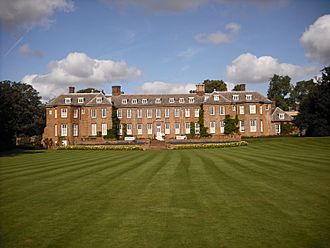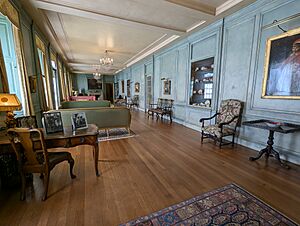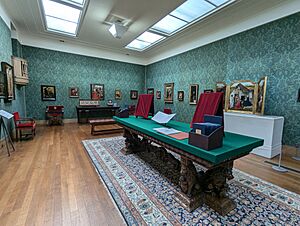Upton House, Warwickshire facts for kids
Quick facts for kids Upton House |
|
|---|---|

The South Terrace
|
|
| General information | |
| Type | Stately home |
| Location | near Banbury, Oxfordshire |
| Coordinates | 52°06′43″N 1°27′35″W / 52.11199°N 1.45966°W |
| Completed | Built c.1695 |
| Owner | in the care of the National Trust |
|
Listed Building – Grade II*
|
|
| Designated | 07 January 1952 |
| Reference no. | 1024175 |
Upton House is a large country house located in Warwickshire, England. It's about 7 miles northwest of Banbury, a town in Oxfordshire. Today, this beautiful house and its gardens are looked after by the National Trust, a charity that protects historic places. Upton House is considered a very important building, listed as Grade II* for its special history and architecture.
Contents
History of Upton House
Upton House was built on the site of a very old village called Upton. Around the year 1500, this village was cleared to make space for fields where animals could graze. Over many years, the land was owned by different families.
Early Owners and Builders
In the early 1600s, Sir William Danvers bought the estate. His family owned it until 1688. Then, Sir Rushout Cullen bought the land for £7,000. He built the main house we see today around 1695.
From Hunting Lodge to Family Home
In 1757, a banker named Francis Child bought Upton House. He used it as a place for hunting. His family, who later became the Jersey family, owned the house until the late 1800s. In 1897, a brewer named Andrew Richard Motion purchased the estate. He was the grandfather of the famous writer Andrew Motion.
The Bearsted Family Era
The most significant changes to Upton House happened after 1927. That's when Walter Samuel, 2nd Viscount Bearsted, bought the estate. He had inherited a large fortune from his father, who founded the oil company Shell. Lord Bearsted's wife, Lady Bearsted, worked with a garden designer named "Kitty" Lloyd Jones. Together, they completely changed the gardens in the early 1930s. Kitty Lloyd Jones turned a marshy area into a special "bog garden" around a natural spring.
In 1948, Lord Bearsted generously gave the house, its gardens, and his amazing art collection to the National Trust. His son, Marcus Samuel, 3rd Viscount Bearsted, lived at Upton House until he passed away in 1986. He also added his collection of beautiful porcelain to the gift. After the 3rd Viscount's death, his daughter, Mrs. R. Waley-Cohen, made sure that the furniture and other items in the house stayed there for the public to enjoy. She lived in the house until 1988.
What Upton House Looks Like
Upton House is a long, low building made from local yellow stone. It was made much bigger between 1927 and 1929 by an architect named Percy Richard Morley Horder. He kept the outside looking like the original 1600s style. However, inside, he added some cool Art Deco features. For example, Lady Bearsted's bathroom has walls covered in shiny aluminum!
The Beautiful Gardens
One of the best parts of Upton House is its garden. A large lawn with huge cedar trees slopes down from the house. Below this, there's a huge terraced garden. The garden also has a kitchen garden where food is grown, colorful flower beds, and a big lake with water lilies in a small valley.
The terraces, which you can't see from the house at first, are home to the National Collection of Aster flowers. The gardens have been used since the 1100s, but Kitty Lloyd-Jones really transformed them in the 1920s and 1930s. She even created the unique Bog Garden where medieval fish ponds used to be.
The Amazing Art Collection
Upton House is special because it's almost like an art gallery inside a country house. The National Trust has worked hard to make the house look like it did in the 1930s. It has a unique Art Deco bathroom and a collection of old Shell advertising posters, including some of the original artwork by artists like Rex Whistler.
How the Collection Grew
Lord Bearsted put together this incredible art collection. He was a trustee of the National Gallery and chairman of the Whitechapel Gallery, which helped him find amazing pieces. In 1948, he even lent his collection of old master paintings for an exhibition in Whitechapel, even though the area was still recovering from World War II bombings. His sister, Nellie Ionides, also loved collecting, especially porcelain.
The collection at Upton House includes paintings by famous European artists like Giovanni Battista Tiepolo, Francesco Guardi, Jan Steen, Thomas Gainsborough, and Rogier van der Weyden. There's also a fantastic collection of English porcelain from famous factories like Chelsea, Derby, and Worcester, as well as some French Sèvres porcelain.
Highlights of the Collection
Some of the most famous artworks you can see at Upton House include:
- Self Portrait of the Artist Engraving (1783) by Richard Morton Paye
- William Beckford (1782) by George Romney
- Bacino di San Marco, Venice (around 1725–26) by Canaletto
- Morning and Night, two paintings from The Four Times of the Day (around 1736) by William Hogarth
- Massacre of the Innocents (around 1565), thought to be by Pieter Brueghel the Younger
- The Labourers (1779), The Haymakers (1783), and The Reapers (1783) by George Stubbs
- The Interior of the Church of St. Catherine, Utrecht (1655–1660) by Pieter Jansz. Saenredam
- The Duet or "Le corset blue" (mid-1660s) by Gabriël Metsu
- The Disrobing of Christ (El Espolio) by El Greco (around 1579)
- Martin Ruzé (1612) by Frans Pourbus the Younger
- The Death of the Virgin (1564) by Pieter Bruegel the Elder, a very important work painted in shades of grey.
- Adoration of the Kings (around 1495), a three-part painting by a follower of Hieronymous Bosch
Inside the House
Dining Room
Lord Bearsted chose this room to display paintings with a sporting theme. This fit well with the estate being used for hunting and other outdoor activities. You can also see a set of dining chairs here that were embroidered by Marcus Samuel, 3rd Viscount Bearsted. He did this as a way to recover from injuries he received during World War II.
Long Gallery
This long, narrow room was created by combining three smaller rooms during the renovations in the 1920s. It features many paintings by Dutch Masters. There are also special display cases designed by Percy Richard Morley Horder. These cases show off a collection of English porcelain from Chelsea, Derby, and Bow, as well as French porcelain from Vincennes and Sèvres. Many of these pieces are decorative figures from the Rococo period.
Porcelain Lobby
This area highlights some of the best pieces from the porcelain collection. It focuses on amazing 18th-century French ceramics. These works come from both the Vincennes and Sèvres factories. Some interesting items include:
- A coffee cup and saucer with pictures of Benjamin Franklin. These were made when he was the French ambassador.
- Part of a table service ordered by Catherine the Great.
- A plate ordered by Madame du Barry.
Picture Gallery Passage
This is a narrow hallway that leads to the main Picture Gallery. Many important paintings from the collection hang here.
Picture Gallery
After the renovations in the 1920s, this room was actually used as a squash court! You can still see a gallery from that time. In 1936, the architect Ernest Joseph turned it into a proper art gallery. Today, it's where the collection's 15th and 16th-century paintings are displayed.



